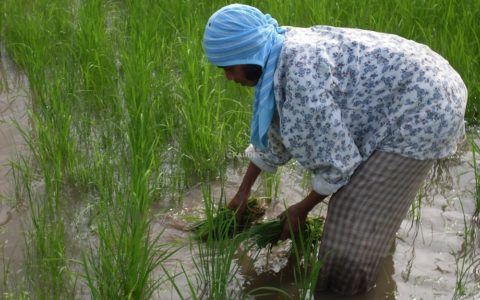Research group IBON doubted that projected revenues from imposing tariffs on unlimited rice imports instead of quantitative restrictions (QRs) on the staple would be enough to support farmers’ production. The group stressed this amid worrisome agriculture decline and increasing food prices, which the National Economic and Development Authority (NEDA) yesterday used to justify proposals for rice tariffication. IBON cited falling direct production support and agricultural budget due to the country’s commitment to trade liberalization deals.
Philippine Statistics Authority (PSA) data shows that the agriculture sector was almost stagnant at 0.2% growth in the second quarter of 2018, coming from generally erratic performance in the same period over the past five years: 3.3% (2013), -0.1% (2014), -2.0% (2015), 6.3% (2016) and 0.2% (2017).
To supposedly improve the agriculture sector’s competitiveness and improve farmers’ incomes, the NEDA backs proposals to amend Republic Act 8178 or the Agricultural Tariffication Law to lift rice QRs and tariffy rice importation.
The administration targets to collect as much as Php28 billion in agricultural tariff revenues for six years. IBON noted that this is higher than current tariff revenues from private sector rice importation of Php2.2 billion annually from 2013 to 2017. Rice imports averaging 314,586 MT annually were within the minimum access volume (MAV) set under the World Trade Organization (WTO) at 35% tariff.
IBON pointed out however that existing support to rice farmers is not even fulfilled as it is. The National Food Authority (NFA) is still falling short of its already vastly reduced procurement target. The agency is mandated to procure palay from farmers at a higher price than prevailing farmgate prices but equivalent only to 10% of projected palay production. The Commission on Audit (COA) also reported that the NFA bought only 28,514 MT or 18.6% of its palay procurement target in 2017, and diverted its Php5.1 billion Food Security Program budget into payments for maturing debts. Also according to the COA, the NFA’s average local palay procurement from 2013-2017 was at a mere 0.8% of local palay production.
In reality, under WTO tenets, the Philippine government has to reduce the NFA’s regulatory functions and has relegated the agency to monitoring private sector importation, or even to importing in behalf of private traders, IBON added. The group noted how supposed NFA subsidies were used to fund private rice importation leading to about Php12 billion in forgone government tariff revenues from 2009-2012.
Pushing agriculture liberalization, the WTO restricts the provision of direct production support to the sector and allows only decoupling payments, such as buying and selling support prices that the NFA does, which do not impact on production.
The group also pointed out how the proposed Php862.3 million reduction in the Department of Agriculture’s (DA) 2019 budget follows the trend of declining support for agriculture. For instance, the Office of the Secretary which facilitates specific support programs for farmers suffered a Php3.47 million cut under the projected 2019 budget.
Short- and long-term measures can be undertaken to boost Filipino farmers’ productivity and welfare, IBON said. Immediately, government can suspend the TRAIN law which erodes farmers’ already meager incomes. Strategically, the country can modify or get out of unfair agreements such as the WTO to regain the policy space to boost domestic agriculture. This can begin with genuine agrarian reform and then continue with substantial government support for farmers covering direct procurement, production subsidies, post-harvest facilities and marketing support.

